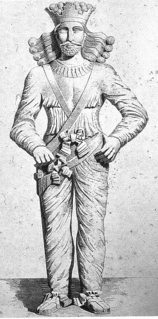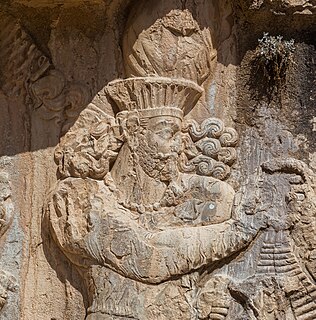
Khosrow I, traditionally known by his epithet of Anushirvan, was the Sasanian King of Kings of Iran from 531 to 579. He was the son and successor of Kavad I.

Kavad I was the Sasanian King of Kings of Iran from 488 to 531, with a two or three-year interruption. A son of Peroz I, he was crowned by the nobles to replace his deposed and unpopular uncle Balash.

Peroz I was the Sasanian King of Kings of Iran from 459 to 484. A son of Yazdegerd II, he disputed the rule of his elder brother and incumbent king Hormizd III, eventually seizing the throne after a two-year struggle. His reign was marked by war and famine. At his accession, he successfully quelled a rebellion in Caucasian Albania in the west, and put an end to the Kidarites in the east, briefly expanding Sasanian rule into Tokharistan, where he issued gold coins of himself at Balkh. Simultaneously, Iran was suffering from a seven-year famine. He soon clashed with the former subjects of the Kidarites, the Hephthalites, who possibly had previously helped him to gain his throne. He was defeated and captured twice by the Hephthalites and lost his recently acquired possessions.

Yazdegerd III (also spelled Yazdgerd III and Yazdgird III; Middle Persian: 𐭩𐭦𐭣𐭪𐭥𐭲𐭩; was the last Sasanian King of Kings of Iran from 632 to 651. His father was Shahriyar and his grandfather was Khosrow II.

Shapur I, also known as Shapur the Great, was the second Sasanian King of Kings of Iran. The dating of his reign is disputed, but it is generally agreed that he ruled from 240 to 270, with his father Ardashir I as co-regent until the death of the latter in 242. During his co-regency, he helped his father with the conquest and destruction of Arab city of Hatra, whose fall was facilitated, according to Islamic tradition, by the actions of his future wife al-Nadirah. Shapur also consolidated and expanded the empire of Ardashir I, waged war against the Roman Empire and seized its cities of Nisibis and Carrhae while he was advancing as far as Roman Syria. Although he was defeated at the Battle of Resaena in 243 by Roman emperor Gordian III, he was the following year able to win the Battle of Misiche and force the new Roman Emperor Philip the Arab to sign a favorable peace treaty that was regarded by the Romans as "a most shameful treaty".

Shapur II, also known as Shapur II the Great, was the tenth Sasanian King of Kings (Shahanshah) of Iran. The longest-reigning monarch in Iranian history, he reigned for his entire 70-year life from 309 to 379. He was the son of Hormizd II.

Narseh was seventh Sasanian King of Kings of Iran from 293 to 303.

Shahrbaraz, was king (shah) of the Sasanian Empire from 27 April 630 to 9 June 630. He usurped the throne from Ardashir III, and was killed by Iranian nobles after forty days. Before usurping the Sasanian throne he was a general (spahbed) under Khosrow II (590–628). He is furthermore noted for his important role during the climactic Byzantine–Sasanian War of 602–628, and the events that followed afterwards.

The Muslim conquest of Persia, also known as the Arab conquest of Iran, led to the fall of the Sasanian Empire of Iran (Persia) in 651 and the eventual decline of the Zoroastrian religion.
The Sasanian army was the primary military body of the Sasanian armed forces, serving alongside the Sasanian navy. The birth of the army dates back to the rise of Ardashir I, the founder of the Sasanian Empire, to the throne. Ardashir aimed at the revival of the Persian Empire, and to further this aim, he reformed the military by forming a standing army which was under his personal command and whose officers were separate from satraps, local princes and nobility. He restored the Achaemenid military organizations, retained the Parthian cavalry model, and employed new types of armour and siege warfare techniques. This was the beginning for a military system which served him and his successors for over 400 years, during which the Sasanian Empire was, along with the Roman Empire and later the East Roman Empire, one of the two superpowers of Late Antiquity in Western Eurasia. The Sasanian army protected Eranshahr from the East against the incursions of central Asiatic nomads like the Hephthalites and Turks, while in the west it was engaged in a recurrent struggle against the Roman Empire.

Rostam Farrokhzād was an Iranian dynast from the Ispahbudhan family, who served as the spahbed of the northwestern quarter (kust) of Adurbadagan during the reign of Boran and Yazdegerd III. Rostam is remembered as a historical figure, a character in the Persian epic poem Shahnameh, and as a touchstone of most Iranian nationalists.
Chiliarch is a military rank dating back to antiquity.

The Sasanian or Sassanid Empire, officially known as the Empire of Iranians, and called the Neo-Persian Empire by historians, was the last Persian imperial dynasty before the arrival of Islam in the mid seventh century AD. Named after the House of Sasan, it endured for over four centuries, from 224 to 651 AD, making it the longest-lived Persian dynasty. The Sasanian Empire succeeded the Parthian Empire, and reestablished the Iranians as a superpower in late antiquity, alongside its neighbouring arch-rival, the Roman-Byzantine Empire.

Sasanian Armenia, also known as Persian Armenia and Persarmenia, may either refer to the periods where Armenia was under the suzerainty of the Sasanian Empire, or specifically to the parts of Armenia under its control such as after the partition of 387 when parts of western Armenia were incorporated into the Roman Empire while the rest of Armenia came under Sasanian suzerainty whilst maintaining its existing kingdom until 428.
Jewish military history focuses on the military aspect of history of the Jewish people from ancient times until the modern age.

War elephants were used in Iranian military history, most notably in Achaemenid, Seleucid and Sasanian periods. The elephants were Asian elephants, and were recruited from southern provinces of Iran, and India but also possibly Western Asiatic elephants from Syria and western-most Iran.
The Paygan were the conscript light infantry unit within the Sasanian army and formed the bulk of its infantry force. The Paygan were sometimes referred to as being used as "cannon fodder".
Hazārbed, also known as hazaruft/hazaraft, was a Sasanian office which functioned as the commander of the royal guard.

The defense lines of the Sasanians were part of their military strategy and tactic. They were networks of fortifications, walls, and/or ditches built opposite the territory of the enemies. These defense lines are known from tradition and archaeological evidence.













